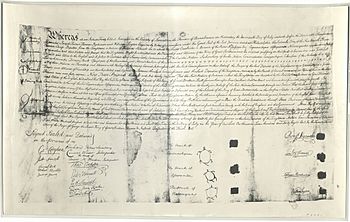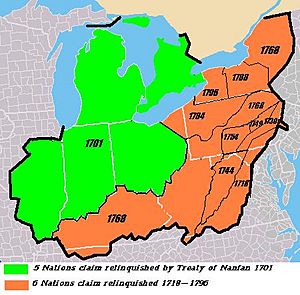Six Nations land cessions facts for kids
The Six Nations land cessions were a series of agreements where the Haudenosaunee (also known as the Six Nations) and the Lenape people gave up large areas of land. These lands included both their traditional homelands and territories they had gained during conflicts like the Beaver Wars. The land was given to the Thirteen Colonies and later to the United States.
These land deals covered parts or all of what are now the U.S. states of New York, Pennsylvania, Maryland, Virginia, West Virginia, Kentucky, Ohio, Tennessee, and North Carolina. To the west, these lands bordered territories held by Algonquian tribes in the Ohio Country. To the south were lands of the Cherokee, and to the southeast were lands of the Muscogee and Choctaw peoples.
The land cessions happened through many purchases and treaties. These agreements were made between the Haudenosaunee and the Province of New York (and later the U.S. government) from 1682 to 1797. In 1701, the Haudenosaunee signed the Nanfan Treaty. This treaty gave their lands north and west of the Ohio River to the Thirteen Colonies. Many of these lands had been won during the Beaver Wars in the late 1600s.
During the early 1800s, the U.S. government moved many Native American groups. Most of the Oneida, one of the Haudenosaunee tribes, moved to Wisconsin. Other Haudenosaunee moved to Ontario in Canada or Oklahoma in the U.S. Today, the Haudenosaunee live in 20 settlements and 8 reservations across New York, Wisconsin, Oklahoma, Ontario, and Quebec.
Contents
Understanding the Background of Land Cessions
Before Europeans came to America, the Haudenosaunee lived in what is now Upstate New York. They were a group of five Native American tribes who formed a strong confederation. The Lenape people lived in the Hudson and Delaware River valleys along the East Coast.
During a time of fighting called the Beaver Wars, the Haudenosaunee fought against Algonquian and Wyandot tribes. These tribes were allied with the French. The Haudenosaunee won many lands, reaching as far west as the Mississippi River and as far south as the Tennessee River.
The Lenape, facing pressure from European settlers, moved west. They settled along the Ohio River and later the Wabash River. In 1701, the Haudenosaunee signed the "Deed from the Five Nations to the King, of their Beaver Hunting Ground." This is better known as the Nanfan Treaty. They signed it with John Nanfan, the colonial governor of Province of New York.
This treaty happened when the English Crown and the Haudenosaunee had good relations. It gave large amounts of recently won territory to colonial New York. However, no one tried to settle these new lands. This was because hostile Algonquian peoples lived there, and the French did not accept the treaty.
Key Land Cessions and Treaties
Between 1682 and 1684, Quaker writer William Penn bought land from the Lenape in colonial Pennsylvania. He got about ten different deeds for areas that are now Chester, Philadelphia, and Bucks counties. These lands were part of the Covenant Chain, a series of treaties between the Thirteen Colonies and the Haudenosaunee. Legend says that in 1682, Penn signed the Treaty of Shackamaxon with the Lenape under an elm tree.
In 1722, Alexander Spotswood, the Lieutenant Governor of Virginia, signed the Treaty of Albany with the Haudenosaunee. This treaty renewed the Covenant Chain. It also agreed that the Blue Ridge Mountains would be the border between colonial Virginia and Haudenosaunee land. In the same year, the Tuscarora tribe joined the Haudenosaunee. This made the confederation into the "Six Nations."
Disputes Over Borders
Despite the agreements, colonial governments could not stop white settlers from moving west. Settlers began moving beyond the Blue Ridge Mountains into the Shenandoah Valley in the 1730s. When the Haudenosaunee complained about these settlers, they were told something different. They were told the border was to stop them from going east of the Blue Ridge Mountains, not to stop colonists from moving west.
In December 1742, the Haudenosaunee had a small fight with white settlers in the Shenandoah Valley. This was called the Battle of Galudoghson. Tensions grew, almost leading to war with Virginian settlers. To avoid war, Sir William Gooch, the colonial governor of Virginia, agreed to pay the Haudenosaunee. He offered 100 pounds sterling for any settled land in the Shenandoah Valley that they claimed.
The next year, in the Treaty of Lancaster, the Haudenosaunee sold their remaining claims in the Shenandoah Valley. They received 200 pounds sterling in gold and 200 pounds sterling worth of goods.

The Treaty of Lancaster also allowed the Haudenosaunee to make peace with the Catawba. They had been fighting on and off for decades. However, the treaty was understood differently by the Haudenosaunee and the Virginia Colony. The Virginians believed the Haudenosaunee had given up all claims within Virginia's 1609 charter borders. These claims theoretically stretched to the Pacific, or at least to the Ohio River.
The Haudenosaunee, however, thought they had only given up their land up to the Shenandoah Valley, east of the Allegheny Mountains. The negotiations for this treaty happened in the Lancaster courthouse. Today, the Soldiers and Sailors Monument stands there.
Later Treaties and Agreements
This difference in understanding was partly fixed at the Treaty of Logstown in 1752. Here, the Haudenosaunee recognized the rights of colonists southeast of the Ohio River. Still, the Cherokee, the Shawnee, and other tribes continued to claim large parts of the region beyond the Allegheny Ridge.
In the 1758 Treaty of Easton, which ended Braddock's War, the Thirteen Colonies agreed to stop settlers from moving west of the Alleghenies. The Royal Proclamation of 1763, issued by the British Crown after Pontiac's War, confirmed that this region was off-limits to white settlers.
By the Treaty of Fort Stanwix in 1768, the Haudenosaunee sold all their remaining claims between the Ohio and Tennessee Rivers. After the Nanfan Treaty, a small group of Haudenosaunee, called the Seneca-Cayuga (or Ohio Seneca/Ohio Cayuga), continued to live in the Ohio Country. They eventually separated from the main Haudenosaunee confederation. Some non-Native settlers used the term "Mingo" for these Native peoples.


